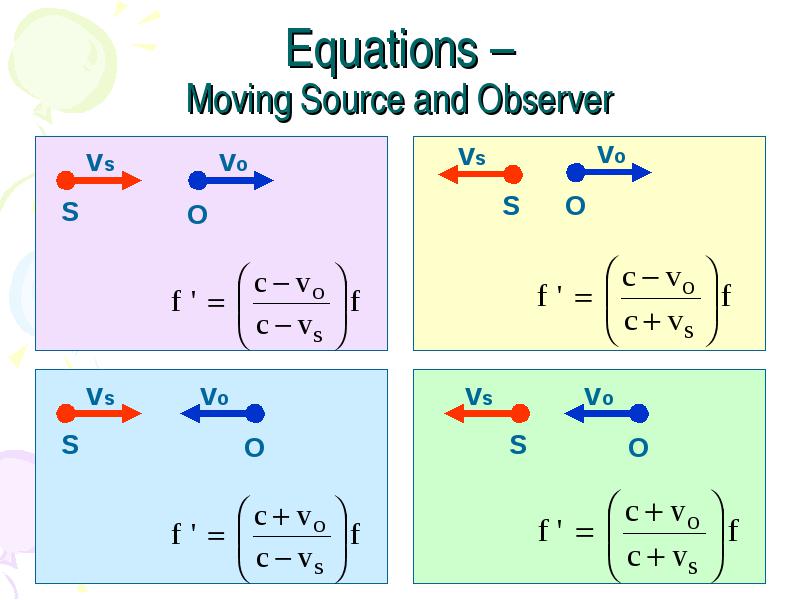

The source, the frequency should go down. What the formula predicts – so far so good. Is moving towards the source of the sound the frequency should go up. How does that enter into this formula? If the observer However, above, we saw that the Doppler effect depends on the direction Here, f is the original frequency and V wave is the speed of the If we call the speed of the observer, V o, the frequency the observer detects will be: The formula for the frequency that the observer will detect depends on the speed of the observer – the larger the speed the greater the effect. If you are moving into a wave, its frequency will appear to you to be higher, while if you are traveling in the same direction as the waves, their frequency will appear to be lower. The same thing is true for sound waves, or any other waves. In fact, if you travel withĮxactly the same speed as the waves, you will not bob up and down at all. Slower rate – you will bob up and down more slowly. In this case, the waves may still overtake you, but at a much That you are returning to shore, and so you are traveling in the same directionĪs the waves. Nevertheless, you would way that the frequency has increased.

Notice, the waves themselves have not changed, only your experience So, the frequency of the waves appears to be higher to you than if you were You will find that you bob up and down more rapidly,īecause you hit the crests of the waves sooner than if you were not moving. If you are not moving, the boat will bob up and down with a certain frequencyĭetermined by the ocean waves coming in. To understand the moving observer, imagine you are in a motorboat on the ocean: We will return to this question in the next section. As it turns out, they are not and this means that you can also learn about who is moving, the source or the observer. You also might think that these two situations are the same. While the second is perhaps the more common situation, the first is easier to analyze. In the other case, you are stationary, and the source is moving past you. For example, you are in a moving car and are passing by a stationary siren.

The first is where the observer is moving. There are two different situations for the Doppler effect that we will investigate. This is a manifestation of the Doppler effect. After passing you, the siren is going away from you and the pitch is lower. At first, the siren is coming towards you, when the pitch is higher. You may have noticed that as a fast moving siren passes by you, the pitch of the siren abruptly drops in pitch. So, what is the Doppler effect? One of the most common examples is that of the pitch of a siren on an ambulance or a fire engine.

Principles in physics, the range of applications can be truly enormous. The rotation of a galaxy, even the expansion of the Universe. Speed of a car on the highway, the motion of blood flowing through an artery, To determine the motion or speed of an object. Like the idea of feedback,Ĭovered in the last two sections, the Doppler effect has many important applications.īecause the Doppler effect depends on things moving, it can generally be used However, if either the source or the observer is moving, Then a simple mixer arrangement can be used to determine the Doppler frequency.So far, we have only considered stationary sources of sound and stationary The most important thing is to use a stable source, meaning that its frequency does not change much at all over time. It is quite remarkable that a radar can perform the comparison of the incident and returned frequencies to such a degree that you can resolve such a slight difference. Notice that the speed of light can be easily 10,000,000,000 times faster than the object. In radar, we are talking about EM waves, so the velocity of the object is compared to the velocity of light. This equation can be applied to sound waves as well as electromagnetic waves. Thus the frequency is shifted higher if the object is approaching, and lower if it is receding (think about the sound that an ambulance makes when it drives toward you, then away from you). Velocity is the component radial to the observer (as opposed to orthogonal), and is positive by convention if the object is moving away from the observer. The equation below shows the relationship between the observed frequency and wavelength compared to the "original" frequency and wavelength. The Doppler shift is what allows a radar to determine the velocity of the target. don't answer that!ĭoppler shift happens when a signal either originates or is bounced off of a "target" that is moving with respect to the observer (the radar). What kind of a nerd would put that plate on his automobile?. Click here to go to our main page on radar


 0 kommentar(er)
0 kommentar(er)
